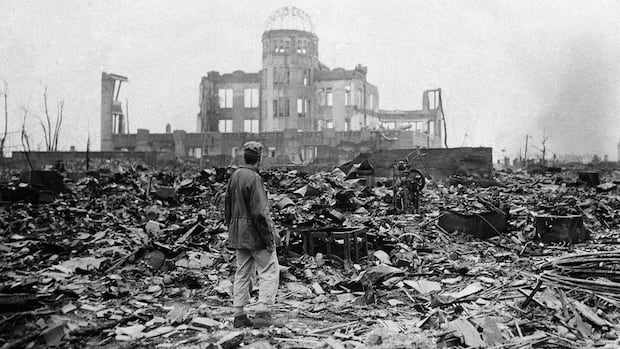How this Canadian survivor of the world's 1st nuclear attack finds hope in 'dark times'
Japanese cultural groups hosting film screening, Q&A in Hamilton with Setsuko Thurlow

With the renewed focus on the threats of nuclear weapons, Setsuko Thurlow feels we are walking through "a very dark time."
Still, Thurlow — a survivor of the world's first nuclear attack, on Hiroshima, Japan, in 1945 — finds hope.
"We did have some positive experiences in recent years. It was not always bad."
The Nobel Peace Prize winner and Order of Canada member spoke to CBC Hamilton as a ceasefire in last month's Israel-Iran war holds. The conflict began with Israel's surprise attacks on Tehran military and nuclear facilities. Over a week into it, the U.S. intervened by bombing three Iran nuclear sites.
Thurlow, who lives in Toronto, is scheduled to be in Hamilton on Saturday for a special screening of a director's cut of The Vow From Hiroshima. The 2019 documentary tells the story of Thurlow, who's known for her advocacy and leadership in the International Campaign to Abolish Nuclear Weapons. It was directed and produced by Susan Strickler, with writer and producer Mitchie Takeuchi.
The event, which runs from 3 p.m. to 6 p.m. ET, is hosted by the Hamilton Chapter of the National Association of Japanese Canadians and the Toronto Japanese Prefectural Association. At the same time, it'll be streamed at an event at the Vancouver Japanese Language School.
Thurlow hopes young people will "carry the torch," and speak out against nuclear proliferation "to ensure the future for you and your children and your grandchildren."
"I really appreciated their thoughtfulness in thinking of me to go around the world and make personal testimony as a Hiroshima survivor. It's been gratifying."
Thurlow, 93, was born in Japan. In 1950, she married Canadian historian Jim Thurlow, who died in 2011.
Thurlow said she's pleased to go to Hamilton for a Q&A following Saturday's screening.
She said nuclear war may seem abstract to many people, but not to her. She also hopes her experience helps people better understand the consequences.
About 170,000 killed by atomic bombs in 1945
On Aug. 6, 1945, the United States detonated an atomic bomb over Hiroshima, killing an estimated 70,000 people instantly. Three days later, the U.S. bombed the Japanese city of Nagasaki with another nuclear weapon, killing an estimated 40,000. A combined 60,000 more people died in both cities within a year due to injuries and radiation poisoning.
In 2011, Thurlow told CBC News she remembered being in class and seeing a flash outside, followed by a feeling of weightlessness before she lost consciousness. When she came to, everything was dark because of smoke and soot. She recalled hearing calls for help and seeing bodies everywhere.
Often, Thurlow said, people only talk about the destruction caused when the bombs detonated, but it's important to understand what happened after, too. All but one hospital in the city were badly damaged or destroyed, and damage to infrastructure was widespread.
"The loss of food, medication and places to live caused unspeakable suffering," she said.
To make matters worse, she said, survivors were censored when they tried to share their experiences in the aftermath.
But out of that horror, Thurlow said, she remained hopeful.
"I admire those adult survivors who became role models. They were determined to live and they were determined to renew their own life, their families and community."
Eventually, Thurlow said, survivors were able to rebuild Hiroshima and share their experiences with the world.

For Thurlow, that also involved campaigning against nuclear weapons, work that would inform the United Nations Treaty on the Prohibition of Nuclear Weapons, which 122 countries adopted in 2017. Canada did not sign on.
Although she wanted a stronger version of the treaty, Thurlow said she was "overwhelmed" by emotions when it was completed. While others cheered, Thurlow said she communicated with her fellow victims of the bombings, letting them know what had happened.
"We made a vow that their deaths would have meaning, and that was for the total elimination and disarmament [of nuclear weapons], so I was reporting to them."
When she accepted the Nobel Prize on behalf of the International Campaign to Abolish Nuclear Weapons, Thurlow said, she could see the faces of loved ones who died.
In January 2025, the Bulletin of Atomic Scientists set its iconic Doomsday Clock to 89 seconds to midnight, representing the closest that organization says humanity has been to destruction in its 78-year history. One of the factors it looks at is nuclear risk. The Bulletin said the war in Ukraine and conflicts in the Middle East were important factors.
"We're in a time of global unrest," said Stéphane Hamade, Hamilton-based vice-president of the National Association of Japanese Canadians. "We really wanted to give that platform to Setsuko Thurlow to give that message of peace that we find very inspiring."
Fewer survivors of Hiroshima and Nagasaki are with us every year, and it's important to hear from them while we can, Hamade said.
"I think hearing from a survivor who has spent so much of her life working on this is a really great way of developing a stronger understanding."



